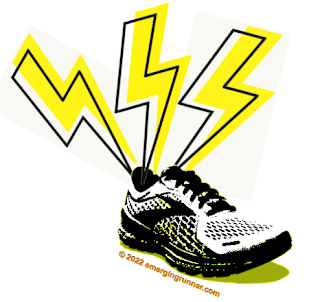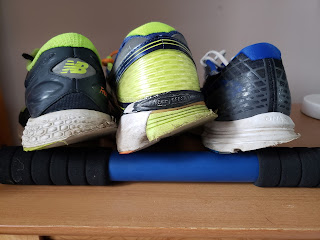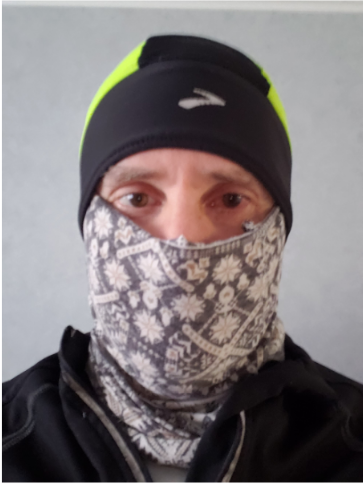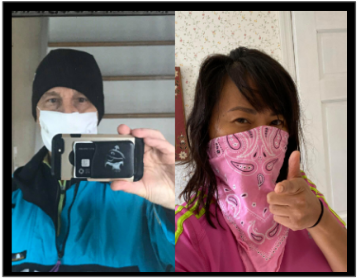Unbelievably, it has been 21 years since September 11, 2001. I wrote this article on 9/11/11 to help preserve the experience and I post it every year on this date. Here it is, once again: Remembrances of 9/11


Unbelievably, it has been 21 years since September 11, 2001. I wrote this article on 9/11/11 to help preserve the experience and I post it every year on this date. Here it is, once again: Remembrances of 9/11
This coincided with two interesting data points:
 |
| I usually prefer downhill, but not in this case |
The Asics Novablast 2
Nova Blast-off!
Conclusion: Even with more structure and weight than I typically prefer, the Novablast 2 provides an excellent balance of responsiveness and protection.
 |
| Brooks Launch 8 |
Instead of stability shoes, the salesperson brought out two neutral options: the Brooks Launch 8 and the Asics Novablast 2. I’ve run in Launch 4s for the past three years and thought it was a solid shoe, but not particularly responsive. The Launch 8 felt a little more energetic than the 4, but not exactly compelling. The Novablast 2 was a very different story.
Once I put the shoe on my foot I knew it was the right choice. The Novablast 2 is nowhere as light as my Reebok Fast 3s, but it had a similar feel underfoot. The cushion and rebound were exactly what I was hoping to find, but the thick midsole was intimidating. Unfortunately, taking them out for a spin wasn’t an option, so I took a chance and bought them anyway.
First Impressions
34mm stack height - yikes!
INSIDE
I was so anxious to run in the Novablasts when I got home that I immediately tried them out for a mile on the treadmill. The first moments of the run were confusing. The Novablasts felt energetic but also a bit unstable. I eventually acclimated to the shoes, but couldn't help wishing they were a few ounces lighter and a touch lower. When I checked my data at the end, I was surprised to see that I’d run much faster than my normal treadmill pace.
OUTSIDE
The next day I took the Novablasts for their first outdoor run. The midsole cushioning was substantial and it minimized harsh ground contact. The soft rebound kept my stride efficient and the hip and leg twinges I’ve felt over the past weeks were barely noticeable. I found the high platform and slight heaviness disconcerting and a few times around corners I wished for more stable footing. With all that, I ended up doing my fastest run in many months.
Time will tell whether I should have tried on more shoes or waited to look for other models that the store didn't stock. Overall, the cost of the Novablast 2s was reasonable and the bounce and comfort I get from them is indeed compelling. I’m hoping the Novablasts will be the shoe that gets me back into long runs and provides the protection for recovery that I don’t get from the other shoes in my rotation.

The handsome couple
 |
| The Shoe-pocratic Oath: "First do no harm" |
 |
| High Octane alternative motion contraption |
 |
| Worn to Run |
 |
| Beware of Hokey Hokas |
.jpg) |
| Lapland Lappers |
 |
| Hattori - 4.4 oz |
 |
| Pure Drift - 5.6 oz |
 |
| All Hail the OMRON! |
Hello? Is this on? Anyone there? Anyone?
 |
| 50% off! |
 |
| Sunny and lonely at Bethpage |
My running in 2020 had its ups and downs. I ran a total of 962 miles (a personal record) and 33% more distance than in 2019. I averaged over 80 miles a month and averaged 3.2 miles per run. My overall pace in 2020 improved 5% over 2019. On the other hand, I only had ten runs greater than 4 miles and only one longer than 5. SIOR maintains that my pace isn't going to improve much until I incorporate a lot more long runs into my schedule.
I'm ambivalent about changing up my regular routine since it seems to work for me. My attempt to move the needle on my performance last fall yielded some improvement, but it was more high effort than foundational. There's an argument to be made that longer runs and (shudder) hill training are the best ways to deliver gains. I was thinking about that on Saturday on my way to Bethpage State Park to run with the Runsketeers. We had planned to participate in the annual Hangover Run at Eisenhower Park on New Years day, but it was cancelled due to Covid.
The Runsketeers decided to kick off 2021 at Bethpage, a venue that seems to work for everyone and happens to be close to a Starbucks that has outside seating. Our post-run Starbucks time is as essential as the run itself. Unfortunately SIOR and Professor Mike had medical afflictions and had to cancel that morning and TPP had to work. I went it alone and planned to run at least 4 miles.
Conditions were good, low 40's and sunny. I felt strong and thought I was running pretty well. The paved path at Bethpage has distance markings every tenth of a mile. As I went along, I was puzzled to see that my Garmin was showing less distance compared to the marked path. I thought it was a GPS error. I ended up running 3.8 miles thinking I'd actually covered four. Later, I Gmapped my route using the exact turnaround positions from my Garmin's download. Despite my perceived performance, I ended up running a less impressive pace.
 |
| Out 'N Back x 2 |
I think I've figured out why the north trail markings differ from my GPS tracking. The first tenth of a mile (position .1 mile) that you encounter isn't actually .1 mile from the trail head. It's actually .05 miles. The marker is, surprisingly, the distance from the top of the steep trail that comes up from the lot to the .1 marker on the north trail. It turns out that four times back and forth from the trail head to the one mile mark is - wait for it - 3.8 miles.
 |
| Me and the Runsketeer recruits |
So lesson learned. I still had a very pleasant run, although I missed my buddies. When I returned to the lot at the end, I encountered four women who were getting ready to head out for their run together. I asked them to take a picture of me that I could send to the Runsketeers and one of the woman asked if I wanted them in it. I said, "Sure, you can be temporary Runsketeers!" I'm sure they had no idea what I was talking about, but I'm used to that.
I did my third run of 2021 this morning before the rain came. It was cold and windy and only about 3.4 miles, but it was nice to know my Garmin is working.
 |
| Hoping for 80 in December |
Hello runners and the running adjacent! It's December 10th: the first night of Hanukah, the 12th day of the Advent and, most notably, national Dewey Decimal System Day.
This is my first after-election post and while I try to stay non-political on this blog, I will say my faith in democracy has been restored by the 81 million people who voted for a return to trust, competence and decency. Let's move on, unify and hope that the next Attorney General puts the current president and his cadre of corrupt criminals in federal prison for a long time. If you don't like what I'm saying here, I invite you to comment below. But please share respectfully and don't put in a link to your stupid product website because I will delete that 🏃
Okay, now onto 2020. The pandemic is getting worse and we are "rounding the corner" into a horrible winter season (see what I did there?). So instead of not running the Seaford Hot Chocolate 5K in Seaford or the Ho-Ho-Ho Holiday run in Bethpage this year, I won't be running the virtual versions of those races. I don't want to race for a couple of reasons. First, I've slowed considerably and I'm self conscious about posting a pathetically weak finish time. Second, I don't really get virtual racing. The best thing about racing is being present with a a bunch of strangers and having the possibility of beating some random person over the line at the last minute. I've done it and I've had it happen to me. I'm talking to you TPP.
A few months ago I decided to test the waters and see what would happen if I actually tried when I ran, rather than defaulting to a comfortable pace. Or as someone in the Running Lovers group in LinkedIn put it, "Slow mindful running." Up until that point I figured I'd just drop a couple of gears and roar back to when I was a mid-pack competitor. I set off on my next run with a pedal to the floor mindset, finished my run and checked my watch. Once my heart rate fell below the point where "vagal maneuvers" would be required, I saw the data.
I was nowhere near my past performance benchmarks but I did see a marked improvement against my running average. Yes, that's a pun. Subsequent runs at vagal imperiling speed brought marginal improvement. I started doing weekly speedwork hoping to unleash a little more speed but I finally reached my performance limit. I realized that in order to move to the next level, I would need to train longer and even harder. I'd have to do regular hill training, long distance runs and maybe even core work. I thought about it and decided to focus on holding the gains I'd recently made.
If you disagree please feel free to comment below 👇
 |
| Today's run on the Bethpage trail |
Last February an ignorant orange man told the country that COVID-19 would soon disappear with the heat, "like a miracle." The only miracle is that, seven months later, 42% of the country still believes him. Sadly, we're pretty much where we were the last time I posted (April 28). If there's anything positive I can say about this, it's that on the road things are pretty much the same as they were pre-COVID. Socially distanced outdoor runs don't require runners to wear masks as long as the six foot rule is rigorously maintained. It's really not that hard to do.
It's been about sixteen months since I've had to commute to a job and my time is structured very differently these days. I now get 8 hours sleep every night and my stress level is pretty low. I give a lot of credit to my 6 day a week runs for keeping me healthy. However, I've recently realized that while daily cardio may be great for my vitals and heart health, it doesn't necessarily mean I'm actually in good athletic shape. Can I run five miles without stopping? Yes. Can I run five miles in 42 minutes like I used to? No. Nein. Nyet. 没有.
During my last checkup in August I asked my doctor why my pace has gone from age group competitive to pathetically slow over the last five years. I'm running a lot more than I was back then and I couldn't understand why all this running wasn't making me any faster. My doctor looked at my chart and said, "Physically there's no reason. You must not be trying hard enough." I knew he was right. I was so inspired that I went out the next morning and did absolutely nothing different because trying was harder than floating through my run.
Since that doctor visit I did try making some changes to my technique that yielded modest speed increases. I focused on cadence and stride length intermittently during runs. The improvement was not dramatic but I did pick up about 30 seconds per mile. Knowing that a little extra effort yielded a marginal performance benefit, I started thinking about ways to really move the needle.
I did a search to see if there was anything online that would inspire me to try harder and I came upon an article about virtual pacers. My old Garmin 210 had alerts that beeped when your pace slowed below a set speed and I was surprised to find a video from DC Rainmaker that showed how to use the virtual pacer feature on my FR35. I had no idea that my watch even had this feature because getting to the menu is not intuitive. But I was able to configure it to beep if my pace went out of range.
 |
| Just hit Run > Run Mode > Virtual Pacer > Edit > Set... |
I've been using the virtual pacer (VP) feature on every run I've done since Friday and my pace has been over two minutes per mile faster on each of those runs. The VP is a great motivator but I needed to own the effort. It's a different experience going out with the gas pedal down from start to finish rather than wending my way through my route at a comfortable speed. The sad part is that I'm pushing very hard to run almost three minutes per mile slower than my former everyday running pace.
I'm determined to run 3+ miles at a 9-something pace by the end of the year. I went out to Bethpage this morning to torture myself on the hills and was pleased that I still paced well, even with my bête noire, the big hill that crests near the parking area. If I can keep this up, maybe I can again run alongside the cool kids: SIOR, KWL, Professor Mike and TPP. Who knew that listening to the doctor could be so helpful!

These days, every conversation has something to do with COVID19, either directly (Do you have it? Do you think you have it?) or indirectly ("We'd be in a completely different situation with competent leadership" or "Let's light a fire on the neighbor's lawn then sneak in through the back door and steal their toilet paper."). The toll of Coronavirus is dominating the news channels and this is very unfair to me because I prefer more uplifting content.
(Non-runners: please skip to the next paragraph) Since I stopped commuting almost a year ago, my weekly running has increased to almost 20 miles and my standing goal is 75 miles a month. So far I've met or exceeded that in 2020. My average run is still about 3.1 miles, so this week I've increased that by an average of 10% per run. I'm looking to do more 4+ mile runs in spring and possibly add another off day (I only have one rest day a week now) while maintaining my weekly target.
While I've had time to run over the past year, I found it frustrating to navigate my neighborhood due to waves of school buses, sanitation trucks and middle school parents flying down the road to drop off their kids. With Coronavirus, school traffic has vanished. There's still Fedex and UPS trucks and I'm starting to see landscapers, but the roads are often clear of vehicles when I go out.
It's not all good news though. Nice weather and stay at home orders have turned my neighborhood into a park. Unless it's raining or especially chilly, I see people everywhere, walking in small groups or alone, some with dogs, some on bikes and some running like me. I deeply resent this. I have great respect for Governor Cuomo and he says to stay in your home. Yet these people are violating the social contract and turning the streets into a Petri dish. The things I want to say as I run by them.
Since the governor hasn't given me special powers to arrest my neighbors who violate his orders, I decided to take things into my own hands. This morning, due to the new recommendation from the CDC to wear a mask in public, I decided I needed one for this morning's run. I have a mask that I use when I do home improvement projects but I don't think it's COVID19 approved. Instead, I went with one of the buffs that KWL's sister sewed for me and my family. I usually wear it in winter to keep my face from freezing on cold windy days, but it seemed light enough for 45° weather.
I took off on my run with the mask placed over my nose and mouth and headed south. That was fine for about five minutes but then I started feeling claustrophobic. My breathing began to feel restricted and the cloth felt damp. I reached an area that had no signs of my law breaking neighbors so I pulled down the mask and immediately felt better. I decided that I'd run with the mask off my face except in cases when I encountered other people. I was able to endure having it up for the short time it took to get past these selfish, non-mask-wearing interlopers. I ended up running about 3.25 and no one got hurt.

Some of my Runsketeer buddies (shown above modeling their COVIDwear) responded as expected when I showed a picture with my running mask (see top pic). TPP said she was having trouble breathing just thinking about running with a mask. Professor Mike said he'd wear his (homemade) mask walking but not running. And SIOR, always supportive, asked me if I was on an Everest Base Camp trek and then said her nurse friend told her running with a mask will make you hyperventilate and make you end up in the ER. Well the jokes on her because I hyperventilated just fine without medical help. However, I will give SIOR credit for inspiring the title of this post.
Should I wear the mask during tomorrow's run? Probably, but I'll only invoke it during those moments when I'm forced to share my road with someone violating
house arreststay at home guidance. I've been discouraged in the past from yelling at neighbors for walking or running on the wrong side of the road so I'll hold back (for now) from berating them for not wearing masks. I mean really, why are these people out there?
 |
| Not exactly a blistering pace but I did get a blister. |
See this post on our new site |
| The three Rs, Running, Resting and Rowin' |
 |
| Sure it is |
 |
| Usual suspects: Mike, TPP, ER, SIOR, KWL
Photo courtesy of woman SIOR asked to take the picture
|
 |
| Happy September, my shirt even had a post-run smiley face |
 |
| Perfect weather for running in circles today |
 |
| Dare to believe |
 |
| I look good in blue |